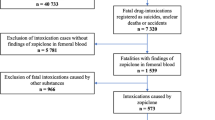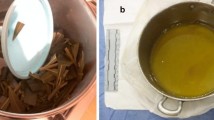Abstract
Herein, we present the case of accidental intravenous injection of gasoline in a 62-year-old male who was admitted to a dialysis center for his regular hemodialysis. Due to previous contact with another SARS-CoV-2 (severe acute respiratory syndrome coronavirus 2) positive patient, the hemodialysis was conducted in an isolated room. At the end of the procedure, the nurse, wearing all necessary personal protective equipment (PPE), in the intent to clean the dialysis catheter, applied medical gasoline, instead of 0.9% sodium chloride, intravenously to the patient. Soon afterwards, the patient’s clinical condition deteriorated, and cardiopulmonary resuscitation was started. Despite the immediate reaction of the medical staff, after two successful cardiopulmonary reanimation and necessary intensive care measures, the patient suffered respiratory, metabolic, and lactic acidosis, hypotension, and tachyarrhythmia and ultimately died 7 h after the incident. The autopsy was conducted under the order of the district attorney. Main autopsy findings were marked congestion; right pleural and pericardial effusion; brain and lung edema; enlarged heart with left ventricle thickening and mild perivascular fibrosis; nephrosclerosis; tubular thyroidization; and interstitial fibrosis with inflammation. Gasoline presence was indisputably proven by conducted toxicology analysis in lung, bile, and brain samples. Traces of gasoline could be noted in the patient’s blood sample in comparison to the blood that did not contain gasoline, but it was not possible to confidently claim that gasoline was present in the blood. Based on relevant findings, we concluded that the death of the patient was violent and that the cause of death was acute intoxication by gasoline.



Similar content being viewed by others
Data availability
All the data and material used in this manuscript are in the possession of authors.
Code availability
Not applicable.
References
Rahman I, Aziz S, Narasimhan K, Owens W (2009) Gasoline Ingestion: A Rare Cause of Pancytopenia. Am J Med Sci 338(5):433–434. https://doi.org/10.1097/maj.0b013e3181b7f2a3
Simay A, Szabo I, Deli L (1968) Experimental contribution on acute changes in the airways during intravenous gasoline poisoning and their treatment. Arch Toxicol 23(3):250–252
Backer LC, Egeland GM, Ashley DL, Lawryk NJ, Weisel CP, White MC, Bundy T, Shortt E, Middaugh JP (1997) Exposure to regular gasoline and ethanol oxyfuel during refuelling in Alaska. Environ Health Perspect 105(8):850–855. https://doi.org/10.1289/ehp.97105850
Reese E, Kimbrough RD (1993) Acute toxicity of gasoline and some additives. Environ Health Perspect 101(Suppl 6):115–31. https://doi.org/10.1289/ehp.93101s6115
Pouwels S, Nijdam C, Zwinkels ML, Struijs MC, Kortekaas R (2018) Thoracic empyema and pectoral abscess resulting from attempting suicide by injection of benzene in the pleural cavity. Respir Med Case Rep 20(24):74–76. https://doi.org/10.1016/j.rmcr.2018.04.010
Fink K, Kuehnemund A, Schwab T, Geibel-Zehender A, Bley T, Bode C, Busch HJ (2010) Suicide Attempt by Intravenous Injection of Gasoline: A Case Report 39[5]:618–22. https://doi.org/10.1016/j.jemermed.2008.08.013
Mahmoodpoor A, Soleimanpour H, Hamishehkar H (2022) Multi organ failure following intravenous gasoline for suicide: a case report. Acta Med Iran 50(12):846–848
Domej W, Mitterhammer H, Stauber R, Kaufmann P, Smolle KH (2007) Successful outcome after intravenous gasoline injection. J Med Toxicol 3(4):173–177. https://doi.org/10.1007/bf03160935
Nelson ME, Nasr I (2013) Parenteral hydrocarbon injection and associated toxicities: two case reports. West J Emerg Med 14(5):431–434. https://doi.org/10.5811/westjem.2013.3.15678
Arena JM (1987) Hydrocarbon poisoning, current management. Pediatr Ann 16(11):879–883. https://doi.org/10.3928/0090-4481-19871101-07
Zavala AM, Day GE, Plummer D, Bamford-Wade A (2018) Decision-making under pressure: medical errors in uncertain and dynamic environments. Aust Health Rev 42(4):395–402. https://doi.org/10.1071/ah16088
Tariq RA, Vashisht R, Sinha A et al (2024) Medication dispensing errors and prevention. [Updated 2023 May 2]. In: StatPearls [Internet]. StatPearls Publishing, Treasure Island (FL). Available from: https://www.ncbi.nlm.nih.gov/books/NBK519065/
HDNDT (2020) Preporuka HDNDT za rad u dijaliznim centrima tijekom COVID-19 pandemije 23.04.2020. Hdndt.org Microsoft Word - COVID preporuke_2304.docx (hdndt.org). Available from: https://www.hdndt.org/corona-virus-savjeti-za-nefrologe. Accessed 24 Jan 2024
Shenal BV, Radonovich LJ, Cheng J, Hodgson M, Bender BS (2012) Discomfort and exertion associated with prolonged wear of respiratory protection in a health care setting. J Occup Environ Hyg 9(1):59–64. https://doi.org/10.1080/15459624.2012.635133
Hajjij A, Aasfara J, Khalis M, Ouhabi H, Benariba F, El Kettani C (2020) Personal protective equipment and headaches: Cross-sectional study among moroccan healthcare workers during covid-19 pandemic. Cureus 12(12):e12047. https://doi.org/10.7759/cureus.12047
Mahalingam K, Surbhi BA, Ganesh R, Daniel RA, Aggarwal R, Soni KD, Singh AK, Khanna P, Gupta V, Trikha A (2022) Is it a challenging task to work with personal protective equipment in a COVID-19 ICU: Findings from a hospital-based cross-sectional study from north India. J Family Med Prim Care 11(5):1935–1942. https://doi.org/10.4103/jfmpc.jfmpc_1937_21
Khoo K-L, Leng P-H, Ibrahim IB, Lim TK (2005) The changing face of healthcare worker perceptions on powered air-purifying respirators during the SARS outbreak. Respirology 1(1):107–110. https://doi.org/10.1111/j.1440-1843.2005.00634.x
Verbeek JH, Rajamaki B, Ijaz S, Sauni R, Toomey E, Blackwood B, Tikka C, Ruotsalainen JH, Kilinc Balci FS (2020) Personal protective equipment for preventing highly infectious diseases due to exposure to contaminated body fluids in healthcare staff. Cochrane Database Syst Rev 4(4):CD011621. https://doi.org/10.1002/14651858.cd011621.pub4
Manookian A, Dehghan Nayeri N, Shahmari M (2022) Physical problems of prolonged use of personal protective equipment during the COVID-19 pandemic: A scoping review. Nurs Forum 57(5):874–884. https://doi.org/10.1111/nuf.12735
MedcomInc (2016) Medication errors in nursing: common types, causes, and prevention. Medcom Inc. https://medcominc.com/medical-errors/common-nursing-medication-errors-types-causes-prevention/. Accesed 19 October 2023
Tejos R, Navia A, Cuadra A, Fernandez-Diaz OF, Berner JE (2020) Avoiding a Second Wave of Medical Errors: The Importance of Human Factors in the Context of a Pandemic. Aesthetic Plast Surg 44(5):1926–1928. https://doi.org/10.1007/s00266-020-01868-y
HealthLeaders (2020) During the Pandemic, Aspire to Identify and Prevent Medication Errors and to Avoid Blaming Attitudes. Healthleadersmedia.com https://www.healthleadersmedia.com/nursing/during-pandemic-aspire-identify-and-prevent-medication-errors-and-avoid-blaming-attitudes. Accessed 19 October 2023
Ferner RE (2000) Medication errors that have led to manslaughter charges. BMJ 321(7270):1212–6. https://doi.org/10.1136/bmj.321.7270.1212
Carayon P, Wood KE (2010) Patient safety - the role of human factors and systems engineering. Stud Health Technol Inform 153:23–46
Author information
Authors and Affiliations
Contributions
All authors listed were actively involved in the preparation of manuscript and have approved the version to be published.
Corresponding author
Ethics declarations
Ethics approval
The presented content completely complies with laws in Croatia and with the ethical standards of the authors’ affiliated institutions. The case report was approved by the ethics committee of the School of Medicine, University of Zagreb.
Consent for publication
Attached in Supplementary Material.
Conflict of interest
The authors declare no competing interests.
Additional information
Publisher's Note
Springer Nature remains neutral with regard to jurisdictional claims in published maps and institutional affiliations.
Rights and permissions
Springer Nature or its licensor (e.g. a society or other partner) holds exclusive rights to this article under a publishing agreement with the author(s) or other rightsholder(s); author self-archiving of the accepted manuscript version of this article is solely governed by the terms of such publishing agreement and applicable law.
About this article
Cite this article
Bubalo, P., Nestic, M., Martinovic, S. et al. Death by accidental intravenous administration of gasoline. Int J Legal Med (2024). https://doi.org/10.1007/s00414-024-03181-8
Received:
Accepted:
Published:
DOI: https://doi.org/10.1007/s00414-024-03181-8




